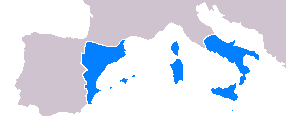Happy First Day of Fall!
As the seasons change, what we eat
changes, and so the wine we drink will change too. Grenache is a perfect autumn
wine – its a nice transition from lighter wines drunk on the patio
during the summer to fuller bodied wines best enjoyed sitting by a
fireplace during winter.
 Grenache (Greh-nosh) is thought to have
originated in northern Spain, and from there transplanted to southern
France and the islands of Corsica and Sardinia. There is also a
school of thought that Grenache is indigenous to the islands and was
brought to Spain after the Spaniards invaded in the 13th
Century.
Grenache (Greh-nosh) is thought to have
originated in northern Spain, and from there transplanted to southern
France and the islands of Corsica and Sardinia. There is also a
school of thought that Grenache is indigenous to the islands and was
brought to Spain after the Spaniards invaded in the 13th
Century.In more recent history, Grenache has been transplanted in Australia, California, and Washington.
 |
| image from wakawakawinereviews.com |
Grenache goes by many names.
In France, Grenache is primarily grown in the south, but Grenache is also grown on the islands of Corsica and Sardinia. Corsica is French, so the grape is called Grenache, but Sardinia is Italian, so there the grape is called Cannonau (KAH-nohn-now).
In France, Grenache is primarily grown in the south, but Grenache is also grown on the islands of Corsica and Sardinia. Corsica is French, so the grape is called Grenache, but Sardinia is Italian, so there the grape is called Cannonau (KAH-nohn-now).
So the same grape is called Grenache,
Garnacha, Canonau, and it used to be called Alicante. You think that's confusing? Wait until we talk about Italian grapes!
Grenache is often blended.
Grenache is often blended.
While you can find wine that is 100%
Grenache, the grape is most commonly a major component of well known
blends.
In Spain, where Grenache is called Garnacha (Gar-nah-char), this grape is a component of wines from Rioja and Priorat.
In Spain, where Grenache is called Garnacha (Gar-nah-char), this grape is a component of wines from Rioja and Priorat.
In the Languedoc area of southern
France, it is often blended with Carrignan.
In the southern Rhone region of France, Grenache is a major component in Côtes du Rhône wines such as
Châteauneuf-du-Pape, Gigondas, and Vacqueyras. In fact, the Côtes du Rhône blend is often called a GSM blend. GSM stands for Grenache,
Syrah, Mourvedre. What's the first grape mentioned? Grenache.
Grenache's drought tolerance made it a
popular grape to grow in California in the first half of the 1900s,
and before Shiraz boom of the 1960s, Grenache was the most planted
grape in Australia.
But what does it taste like?
Grenache makes a wine with low tannins
and low acid, but a fair amount of body and alcohol. The texture is
plush and velvety and there are flavors of strawberries, raspberries,
and plums. Not fresh fruit flavors, but more like dehydrated fruit or
a fruit roll. You may get a hint of cinnamon too. Grenache from
southern France may have an herbal quality (think oregano), and wine
from the volcanic islands of Corsica or Sardinia will have a mineral
quality.
Grenache is also used to make awesome rosés in France (particularly Tavel and Lirac), and its used to make fortified dessert wine in both France (Banyuls, Maury, and Rasteau)
and Sardinia (Cannonau liquoroso). I'll describe those in detail in a
future post.
Its got flames on the label, so its got that going for it, which is nice.
Its got some black cherry going on,
with some raspberry darker fruit flavors and some definite smoke,
earth, pepper, and cinnamon. There's also a little tickle in the back
of your throat from the 14.5% alcohol.
Tres Picos is a classic Spanish
Garnacha at a great value (about $17). You'll taste blackberries,
strawberries, and plums with hints of licorice and herbs. Its got a
plush texture that feels like wearing your favorite sweater on a fall
day.
I love anything coming from Domain Lafage. This GSM blend (Remember, that's Grenache, Syrah, and Mourvedre) that has cooked raspberry & strawberry flavors with blackberry and black cherry too. You'll notice some herbal notes like oregano, which is typical of Grenache grown in the south of France. ($15)
Grenache grown on the island of
Sardinia makes wine that tends to be a litte lighter bodied and lower
in alcohol than Grenache grown in warmer areas. The volcanic soil
also contributes to the slightly iron finish. This is Italy, and the
wine goes by the name Cannonau.
If you want something rustic and
informal with a tinge of minerality, try Cannonau. I like to pair it
with a BLT and sweet potato fries.
Syncline is a Washington State winery
that makes two different Grenache blends. Subduction Red
is a fruit forward GSM blend. The Grenache/Carignan is a little more
rustic than the Subduction Red. Its Syncline's version of a popular blend
from the Languedoc region of France. Both of these wines will be more
fruit forward and less earthy than their French inspirations.
Food Pairing
Roasts and stews pair well with the
fuller body of Grenache, particularly dishes roasted with tomato or
eggplant. If you are breaking out the crockpot, break out a bottle of
Grenache.
For cheeses, Grenache's low tannins and
full body help it pair with fuller bodied cheese like Cheddar, Gouda,
Edam, or Mimolette (if you can get your hands on Mimolette). Try
Grenache with Mahon, a Spanish cow's milk cheese made on the island
of Minorca.






No comments:
Post a Comment